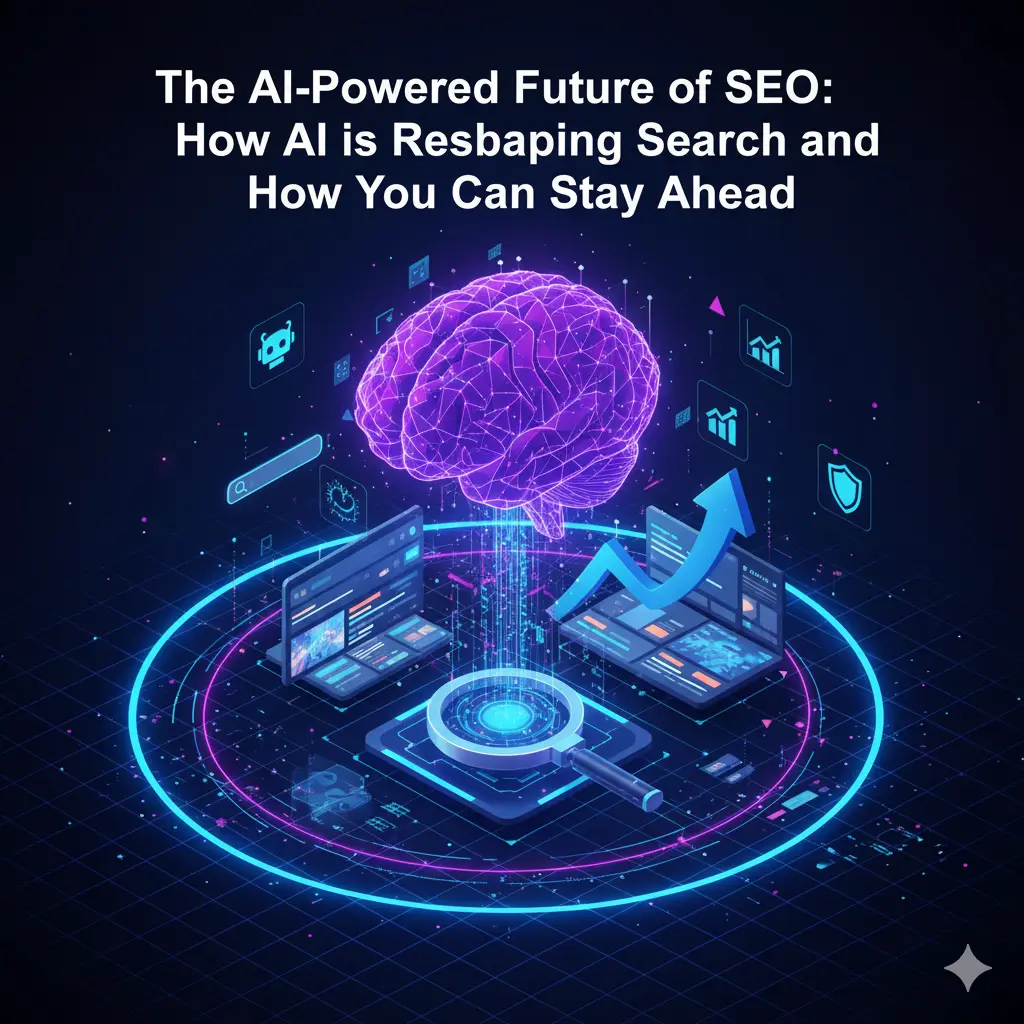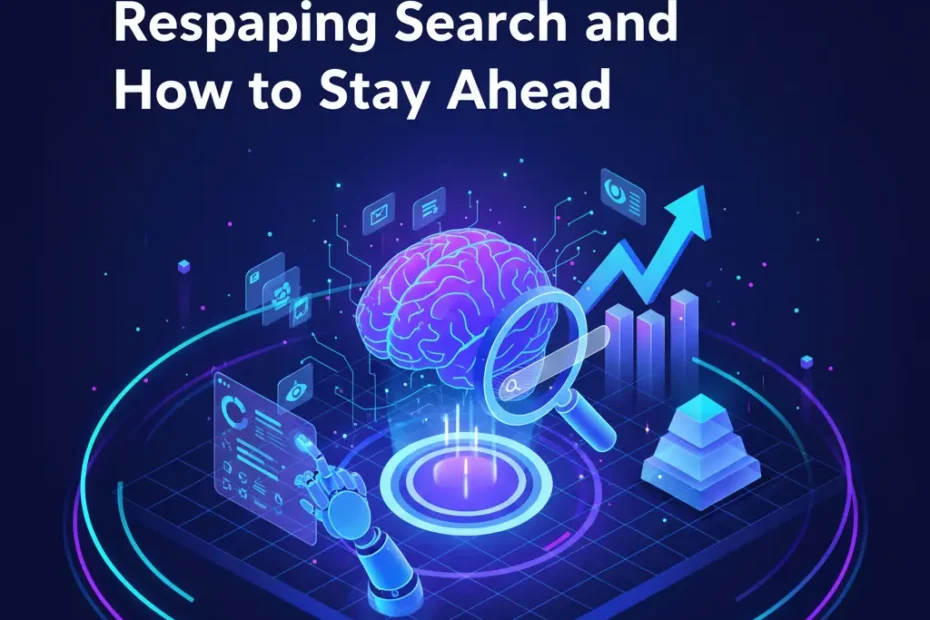Master the future of search! Learn how AI and SEO are merging and discover the cutting-edge SEO trends to future-proof your strategy. Get an expert SEO service guide.
The AI-Powered Future of SEO: How AI is Reshaping Search and How You Can Stay Ahead

The era of simply matching keywords to content is over. The future of search is contextual, personalized, and conversational, driven entirely by AI. The biggest shift is the move from traditional Search Engine Optimization (SEO) to a blend of Answer Engine Optimization (AEO) and Generative Engine Optimization (GEO).
The challenge for every business is clear: How do you ensure your content is the trusted source cited by an AI Overview, rather than one of the links the user never clicks?
1. The New Imperative: Hyper-Focus on E-E-A-T for AI and SEO Success
As the internet becomes saturated with scalable, AI-generated content, Google’s emphasis on E-E-A-T (Experience, Expertise, Authoritativeness, and Trustworthiness) has never been more critical. This is the ultimate filter AI models use to separate “commodity content” from “citation-worthy content.”
- Experience & Expertise: Content must go beyond summarizing existing information. Share unique case studies, original research, personal anecdotes, and proprietary data that demonstrate firsthand knowledge. This is how you create Original & Valuable content that avoids AI-generated fluff.
- Authoritativeness & Trustworthiness: Feature clear, credible author bylines. Gain authoritative backlinks and brand mentions from recognized industry sources. Your technical foundation (HTTPS, clear privacy policies) contributes directly to this trust signal, essential for any modern SEO service.
2. Optimize Content Structure for Generative Engine Visibility (GEO)
AI Overviews (like SGE) provide synthesized answers directly on the SERP, leading to the rise of the ‘zero-click’ search. The core strategy to combat this is to structure your content so the AI must use you as a source. This is the essence of Generative Engine Optimization (GEO).
- Schema Markup Implementation: Use Schema Markup (like FAQ, How-To, Q&A, and Article schema) meticulously. This helps AI models understand the hierarchical structure and specific nature of the information, increasing the likelihood of being featured in a snippet or overview.
- Clarity and Conciseness: AI is trained to extract direct answers. Organize sections with clear subheadings (
<h2>,<h3>) and use bulleted or numbered lists for key takeaways and steps. This makes the content instantly digestible and quotable for LLMs. - Multimedia Integration: Integrate relevant and accessible Multimedia (images, videos, infographics) within the text. Search AI is becoming increasingly multimodal; optimizing image alt-text and providing video transcripts can capture visibility across different search mediums.
3. Mastering the Conversational Keywords (Future of Search)
AI has trained search engines to understand human language, context, and complex intent better than ever. The future of search is conversational.
- Intent-First Strategy: Focus on the why behind a query (informational, transactional, navigational). Content should answer the user’s underlying need, not just match the keyword string.
- Long-Tail and Conversational Queries: Shift your Keyword-Optimized strategy to natural, long-tail, and question-based queries (e.g., “how to use an AI tool for SEO keyword research” instead of “AI SEO tool”). These are the phrases users speak into voice assistants and type into AI chat interfaces.
- Internal Linking and Topic Clusters: Use Internal Linking to build robust topic clusters. By linking related content, you signal to AI that you have deep authority and Expertise across a comprehensive subject area, a critical factor for earning citations.
4. Prioritize Technical SEO and User Experience (The Core AI and SEO Signals)
AI-powered algorithms (like RankBrain) heavily scrutinize user experience metrics. Fast, accessible sites are seen as more trustworthy and authoritative.
- Core Web Vitals: Ensure your site is Fast-Loading and Mobile-Friendly. Metrics like Largest Contentful Paint (LCP) and Cumulative Layout Shift (CLS) are essential for satisfying the user experience algorithms that AI models rely on for ranking signals.
- Mobile-First Design: The vast majority of search is mobile. Your site’s responsive design must provide a seamless experience, a fundamental requirement for the future of search.
- Regular Updates: Commit to maintaining and Updating Regularly. Stale content is viewed as less trustworthy by both human users and AI systems. Audits and content refreshes should be a recurring part of your SEO service offering.
5. Leverage AI Tools for Proactive SEO Trends Analysis
The final step in staying ahead is using AI to fight AI. The most effective SEO service providers are integrating AI tools into their workflow to enhance human strategy, not replace it.
- Predictive Analytics: Use AI tools to analyze massive data sets, helping you predict SEO trends and identify emerging conversational queries before competitors.
- Efficiency and Scale: Use AI for efficient, yet human-reviewed, tasks like summarizing competitor content, generating meta descriptions, and conducting large-scale technical audits.
- Ethical Content Creation: While AI can draft, the final product must retain the unique voice and human Experience to avoid generic output. Always maintain No Plagiarism standards and ensure human editors infuse the content with verifiable, unique insights.
The AI and SEO revolution is here. By focusing on E-E-A-T, optimizing your content structure for Generative AI (GEO), and maintaining an impeccable technical foundation, you can move confidently into the future of search and ensure your brand remains the authoritative answer engine for your industry.
